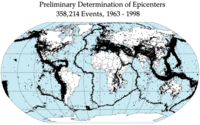
Photo from wikipedia
The El Hierro volcanic unrest started in July 2011, with an increase in observed seismicity rates and surface deformation. After the initial onset, hypocenters migrated southward through September 2011, culminating… Click to show full abstract
The El Hierro volcanic unrest started in July 2011, with an increase in observed seismicity rates and surface deformation. After the initial onset, hypocenters migrated southward through September 2011, culminating in a submarine eruption beginning on October 10, 2011 and finishing in February 2012. The seismic activity continued, with remarkable periods of unrest through 2012 and 2013. The most significant episodes of seismic activity during this unrest are related to magma migration at depth. In this work, we compute tidal stress for each earthquake, at its hypocenter depth, and assign them a tidal stress phase angle. We have found statistically significant correlations between the occurrence of earthquakes and tidal stress phase angles, corresponding mainly to increasing tidal stress change rates. We found primarily that the magnitude of vertical and E‐W horizontal tidal stress values and their changing rates with time were correlated with earthquake occurrence times. We also found that there is no correlation between tides and seismicity at times with no observed surface displacements, suggesting that tidal modulation might be related to overpressure during migration of magma. Tidal modulation changes with depth and the influence of ocean‐loading tides is stronger than the influence of solid Earth tides. Our results support the hypothesis that tidal stress may modulate the seismicity during volcanic unrest, particularly during shallow depth magma migration.
Journal Title: Tectonics
Year Published: 2021
Link to full text (if available)
Share on Social Media: Sign Up to like & get
recommendations!